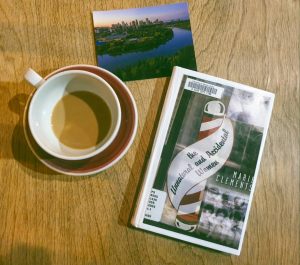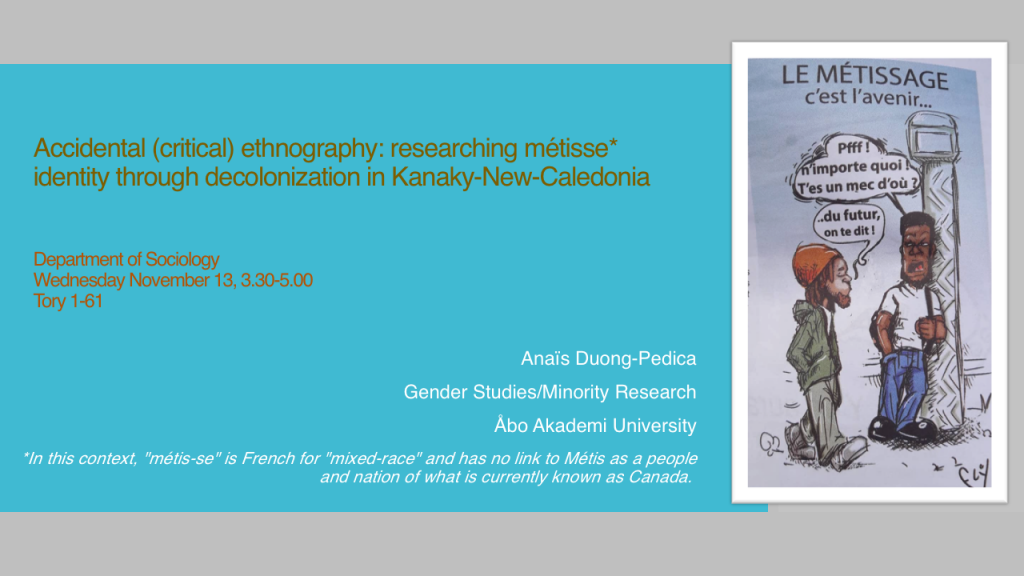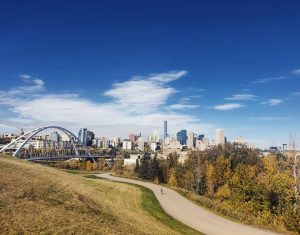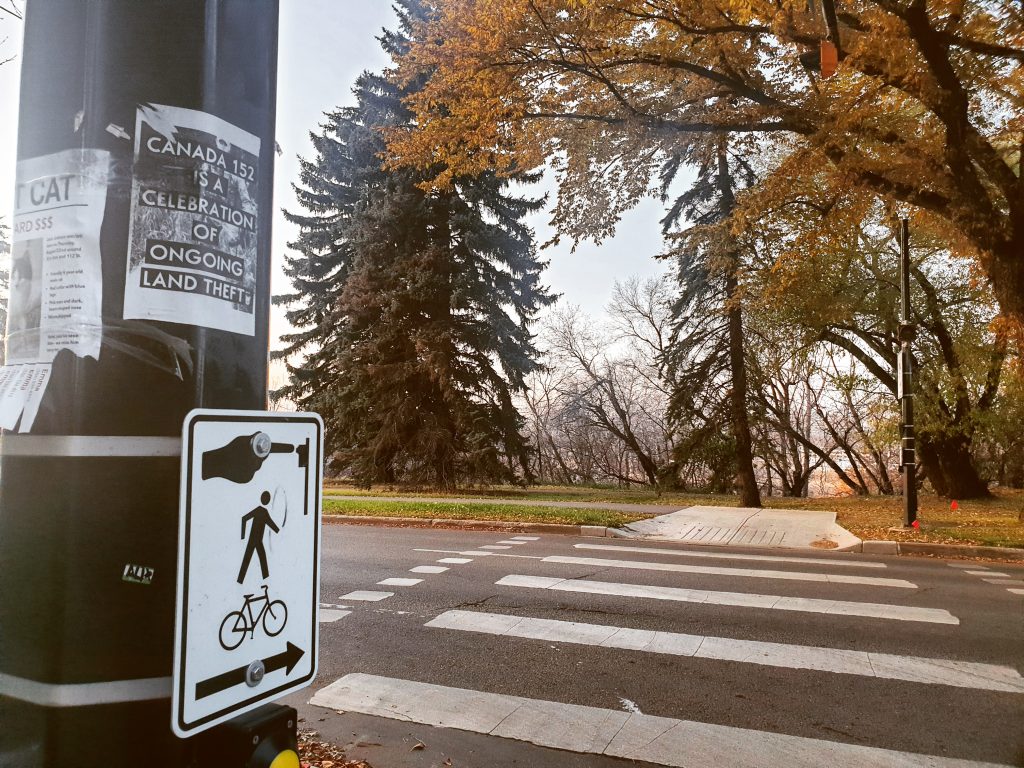Thanks to the ÅAU Research Mobility Grant, I had the opportunity to be a visiting PhD student in the Department of Sociology at the University of Alberta in Edmonton on Treat 6 Territory, in what is currently known as Canada, between September and December 2019. Being the home of many Indigenous communities, including the Cree, Saulteaux, Nakota Sioux, Blackfoot and the Métis Nation, Edmonton’s traditional name is Amiskwaciy Waskahikan in Nehiyawak (Cree). My main goal there was to work with one of my supervisors, Prof. Shirley Anne Tate, on my research on ‘mixed-race’ identity in Kanaky-New-Caledonia (KNC). As a PhD in the Minority Research profile, the visit allowed me to further explore the ways in which global systems of domination work together to oppress, exclude and disappear Black and Indigenous peoples. As a researcher, I was able to attend a variety of events organized by staff and students at the University of Alberta, such as events organized for the International Year of Indigenous Languages and the Working the Intersections of Gender conference.
I was fortunate to be able to audit two classes at the university: Studies in Indigenous Theatre, Performance and Politics with Dr Selena Couture, and Colonialism, Postcolonialism and Globalization with Prof Shirley Anne Tate, as well as take a free online class hosted by the Faculty of Native Studies: Indigenous Canada. This allowed me to make links between the issues faced by Indigenous nations in Canada but also the legacy of slavery and ongoing anti-blackness in the Transatlantic region and elsewhere around the globe, with the continuing colonialism and racism predominantly experienced by kanak in Kanaky-New-Caledonia. I also paid attention to the ways in which people resisted settler colonialism within and outside the institution and attempted to make links with settler-Indigenous relations in the Pacific and the struggle for sovereignty in KNC. One such ways is the PÎTOS-MÂMITONEYIHTAMOWIN (REIMAGINE) UALBERTA website which was created “to highlight Indigenous, or perceived Indigenous places, spaces & art located on the University of Alberta North Campus. The website is home to a hub of alternative perspectives around Indigenous or perceived Indigenous statutes, artwork, places & spaces at the University of Alberta”.

At the ᐄᓃᐤ (ÎNÎW) River Lot 11∞ (click on the link to read a guide written by Mackenzie Brown on Exploring Indigenous Edmonton) Preparing to Cross the Sacred River by Marrianne Nicolson

At the ᐄᓃᐤ (ÎNÎW) River Lot 11∞ Isoktew by Amy Malbeuf
Taking courses was beneficial to my research as auditing a course in the Department of Drama encouraged me to engage with critical work and artistic practices outside of my study area and explore my research topic from a variety of standpoints. In fact, reading Indigenous playwrights and critical pieces on Indigenous theatre and performance on a weekly basis inspired me to write one of the papers for the PhD on the politics of ‘mixed-race’ identity in Jenny Briffa’s “Fin Mal Barrés !”, a local play on independence/referendum politics. It was also beneficial to my teaching practice as it enabled me to observe different pedagogical methods and learn collectively with other postgraduate students and teachers. As a teacher, I appreciated seminars like ”Approaches to the Inclusive Classroom” and the ability to discuss how we can change our practices as teachers in order to facilitate disability justice, anti-racism, anti-colonialism and feminism in the classrooom. As a PhD student, I was happy that ”Writing Bootcamps” were organised by the Faculty of Graduate Studies, which provided us with a booked room, writing tips and food and beverages throughout the day to allow us to focus on writing.

Marie Clements’s play ”The Unnatural and Accidental Women” which we read and saw live as part of the course in Indigenous theatre
The University of Alberta has around 40,000 students and employs more than 14,400 people. Contrastingly, about 5,500 students are registered at Åbo Akademi and the university has about 1,100 employees. This has an impact on the resources allocated to research and the variety of research fields and programmes offered at both universities. Indeed, the University of Alberta library had access to a significant amount material in my fields of interest. Thanks to having access to many journals and books, I was able to read and collect material that I will be using in future articles.
During my stay, I also had the opportunity to present a methods paper in one of the Department of Sociology’s seminars entitled “Accidental (Critical) Ethnography: Doing research on métis-se identity at a time of decolonization in Kanaky-New-Caledonia”. This was a good occasion to share my research process and project, raise awareness on the political stakes in KNC and get feedback on the research.
From a personal perspective, I enjoyed being in a larger city (Edmonton is about 5 times bigger than Turku and 1.5 times bigger than Helsinki!) where events were happening on a weekly basis. I went to public readings, standups, art exhibitions, screenings… I had also missed independent (secondhand) bookshops that sell anglophone or francophone literature and came back with suitcases mostly full of books. If Edmonton happened to be much colder than Turku at the beginning of winter, the beautiful Saskatchewan river divides the city in two, much like the Aura does Turku – although, again, there was quite a size difference! While most of my time was spent in the university library or in cafés reading and writing, I managed to make a bus trip to Calgary where I met a friend who drove us to Banff National Park. There, we saw a frozen Ho-Run-Num-Nay (“Lake of the Little Fishes” in Stoney Natoka) also known as “Lake Louise”. I was thankful for the opportunity to see these beautiful landscapes before flying back to Europe.

Screening of Tasha Hubart’s documentary ”nîpawistamâsowin: We Will Stand Up” on the racism of the Canadian justice system and Colten Boushie’s family’s fight for justice, at Garneau Theatre.
Research mobility is an important part of my research as the focus of my study is the Pacific and I am based in Finland. Being able to share your approaches, ideas, process with other scholars and students and to learn from their own research and teaching practice is a real advantage in research. Therefore, research mobility should be accessible to all at ÅAU. As a PhD candidate, I am very aware that accessing this grant was only possible because I am one of the few salaried postgraduate students. Many colleagues do not have this opportunity because they are unsalaried.
The Mobility Grant is a wonderful opportunity to meet scholars in other parts of the world and to be able to make transnational connections. My advice for future applicants would be to pick a university and department(s) that are dynamic in their various fields of interest but that are also lively outside of the university. In my case, the city was very rich in cultural and political events. Also, I would encourage everyone to take the opportunity to learn from other scholars in seminars but also courses offered by the university (even if one is no longer a student!).










